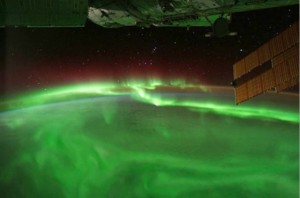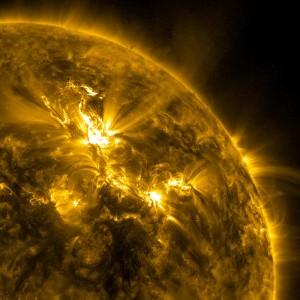Judging by the many
flares erupting
from the sun at the moment, it is well on
track to reach its next
peak in activity early next year.
As this peak approaches, we can expect many
more huge bursts of energy that erupt from
the sun and send lots of energetic
particles, and sometimes magnetic fields,
our way. These in turn will lead to more of
the fantastic
light displays,
which you might have seen (or at least heard
about) lately, creeping down from the North
Pole towards the equator.

Aurora as
seen from the International Space
Station as it crossed over the southern
Indian Ocean on September 17, 2011.
Credit: NASA
These
light shows are the visible sign that a
geomagnetic storm is raging overhead. But
there’s another phenomenon that happens
alongside the northern lights that you won’t
have noticed at all. Surrounding our planet,
way up above the atmosphere, is a doughnut
shaped ring of charged particles held in
place by Earth’s magnetic field. In fact,
there are two of them. They’re called the
inner and outer Van Allen belts.
The Van Allen belts were
found in 1958 and were the first major
scientific discovery of the space age.
During geomagnetic storms, electrons in the
Van Allen belts have been known to vanish –
only to return a few hours later. This
strange phenomenon was first spotted in the
1960s, and has puzzled physicists ever
since.
Surely, they thought, at the
height of a geomagnetic storm in which many
energetic particles from the sun hit Earth’s
atmosphere, there would be more electrons in
the Van Allen belts, not less?
A new paper published
online at Nature Physics seems
to have the answer: the electrons are swept
away by particles from the sun.
Drew Turner, from the
University of California, Los Angeles, and
his colleagues (also at UCLA) used data from
three different spacecraft for this
research: THEMIS, GOES
and POES spacecraft.
THEMIS stands for Time
History of Events and Macroscale
Interactions during Substorms (and is also
the name of a Greek goddess, something that
I’m guessing wasn’t entirely coincidental)
and was a NASA mission that investigated
what causes auroras to go from moving slowly
across the sky to dancing rapidly within
minutes. It consisted of five identical
satellites that lined up over North America
once every four days to witness auroras.
The original THEMIS mission
ended in 2009. Now two of the satellites
have been sent off to orbit the moon and
only three remain close to Earth. Those
three were teamed up with two GOES
(Geostationary Operational Environment
Satellite) and six POES (Polar Operational
Environmental Satellite) spacecraft, both
run by the National Oceanic and Atmospheric
Administration (NOAA), with the POES also
jointly run by European Organization for the
Exploitation of Meteorological Satellites,
to witness a small geomagnetic storm on 6th
January last year.
THEMIS and GOES both orbit
Earth near the equator, with POES taking on
the polar regions at a lower altitude, and
pass through the Van Allen belts several
times a day.

A solar
flare accompanied by a coronal mass
ejection (CME) erupted from the sun on
January 23rd 2012. Credit: NASA/SDO
There
are several solar phenomena that can cause
geomagnetic storms. Coronal mass ejections,
or CMEs, are one that we hear about a lot,
possibly because of the amazing images that
NASA mission Solar Dynamics Observatory (SDO)
has been talking of them lately. But what
caused the storm on 6th January 2011 was
something called a co-rotating interaction
region (CIR). CIRs are created because there
are two different streams of particles
coming from the sun: fast and slow. The fast
stream taking over the slow one causes
turbulence at the boundary between the two
and creates a CIR.
During the 6th January storm,
several satellites in the outer Van Allen
belt noticed a ‘dropout’ of electrons – they
appeared to go missing, but reappeared again
around six hours later.
Turner and his colleagues
looked at the data from the THEMIS, GOES and
POES satellites and found that, while some
electrons at lower energies did appear to
have been replaced by electrons coming in
with the CIR that caused the storm, ones
with higher energies were pushed out from
the Van Allen belts and away from Earth.
Some physicists thought that
the electrons might have fallen downwards
out of the belts during geomagnetic storms,
but this new research is clear evidence that
they seem to be pushed up and away instead.
It might seem like a small distinction, but
information on how the Van Allen belts work
is important if we are to properly protect
satellites flying around in them.
An upcoming NASA mission, Radiation
Belt Storm Probes (RBSP)
should be able to help give a fuller answer
to what happens to the Van Allen belts
during these storms. It’s due to launch this
August – just in time to witness the many
solar storms that will come our way in the
run up to the next solar maximum.
Reference
Turner, D., Shprits, Y.,
Hartinger, M., & Angelopoulos, V. (2012).
Explaining sudden losses of outer radiation
belt electrons during geomagnetic storms Nature
PhysicsDOI: 10.1038/nphys2185



